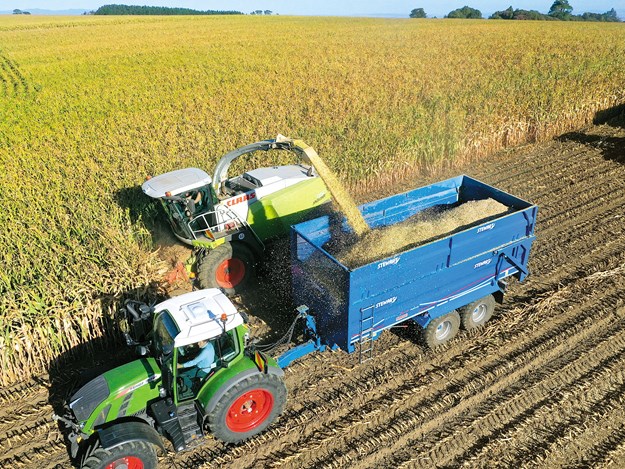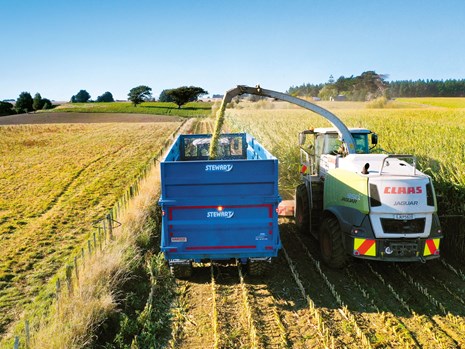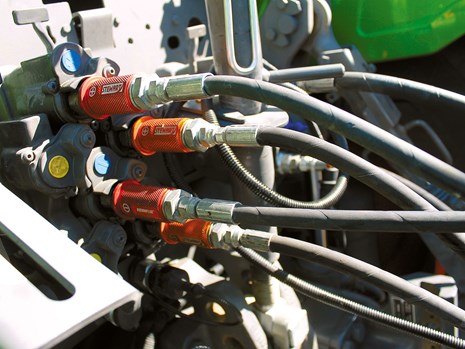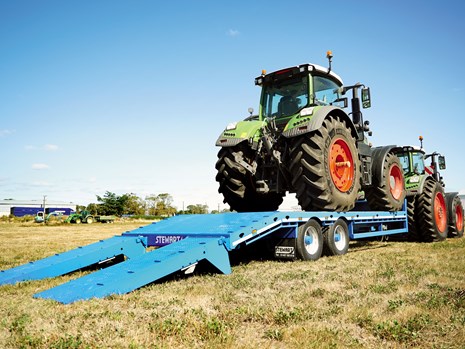Test: Stewart Trailers
Proving popular in New Zealand, the Scottish-made range of Stewart Trailers is impressing

Well-known for producing some of the world’s finest single malt whisky, Scotland is also home to the Stewart Trailers range. TRC Tractors in Feilding boasts an impressive collection of Stewart Trailers in stock, from a basic eight-tonne model through to the larger low loader trailer, which we decided to load up with a Fendt 9 Series tractor to demonstrate its load-carrying capacity.
That particular trailer was heading to a local contractor for transporting his digger and bulldozer between jobs and had been customised to suit, with a timber floor to stop machines sliding and a stainless toolbox for chain/strop storage as just a couple of the personalised features.

Plucked from the selection, though, we chose the PS 16 21 HZ for our trailer test review. This is a custom-built (indicated by the HZ in the name) grain trailer model, originally with a 16-tonne capacity before adding the silage sides. Grain capacity is 21 cube, and with the addition of the silage sides, capacity is 35 cubic meters.
After spending some time looking over the full Stewart Trailer range, we hooked up the PS 16 21 HZ and headed towards Marton to catch up with a contractor working on a maize block, who was happy to have an extra tractor and bin on the job.
TRC Tractors salesman Logan Berg has first-hand experience with the Stewart brand from time spent abroad (like many young Kiwis) harvesting and hauling grass, maize, and wheat on his OE. The contractor he worked for in Scotland was operating with the Scottish-made trailers, and after returning to New Zealand, Logan worked for Miers Contracting (in Reporoa), who have also used Stewart Trailers.
 |
|
The Stewart grain trailer enjoying life as a silage hauling machine
|
These days, Logan is in direct contact with Stewart Trailers’ business owners James and Mandy Stewart, streamlining the process for ordering trailers to suit the specific needs of New Zealand customers.
Test time
We wanted to see and use these trailers ourselves however to assess performance and design first-hand. With our test trailer attached to a Fendt 720, it was bigger than the trailers currently being used by the contractor, offering efficiencies in less downtime for the harvester waiting for trailers, potentially saving the cost of running an extra tractor, bin, and driver.
 |
|
Built tough with Hardox
|
The extra size didn’t appear to offer any real disadvantages, and even at 2.45 metres wide, 10-foot gates are manageable. In fact, with the four-leaf suspension as opposed to the older basic walking axle, it was more stable going through the hollows of the gateways.
Performing as a grain trailer, the silage top was added. Stewart Trailers use a wedge-type system to allow this to fit snugly without causing extra rattling. The hydraulic door also locks in tight, so you don’t hear the noise of the silage trailer coming five kilometres away. Dumping is quick and efficient, with dual hydraulic rams giving a smooth, even lift. The dump pivot point of the trailer is in the main runners of the chassis.
 |
|
The mesh front allows for good visibility when loading>
|
The loading height is kept low by clever design, which allows the top chassis to fit inside the bottom chassis. This also provides improved strength and stability.
As you’d expect from a trailer of this size, taillights are standard and are mounted on the chassis, away from the dump zone and protected by stainless steel guards. Rear orange flashing LED is also standard with wiring to connect extra lighting should it be required.
 |
|
Colour-coded couplers for easy connection
|
Operation
Now you wouldn’t think there would be much to say when it comes to details on trailer operation; it’s all pretty straightforward. However, each trailer comes with its own specific manual, as all custom trailers are different.
 |
|
The deck frame sits neatly between the chassis for low loading height and added strength
|
Each trailer also has a serial number, which can be quoted when ordering parts to help speed up the process. Among the latest features available is the useful tyre inflation system, which allows you to make the most of the latest tyre technology. This nifty system can raise tyre pressure from 35psi in the paddock to 70psi for road haulage in just 45 seconds, using speed sensors to ensure it’s done correctly to prevent damage to the expensive rubber feet.
 |
|
The stainless steel toolbox is just one of the customisable options available
|
The manual also includes details on grease points, etc. if you haven’t fitted an auto lube system. Also worth noting is that the hinge pin is the full width of the chassis, fitted with grease points at the bushes. One of the simplest (even better than cable tying hydraulic lines) and best features is the alloy plus and minus colour-coded hydraulic couplers. This makes sure each one goes in the right hydraulic bank, the right way round, the first time, with no jumping in and out to change or altering in the screen to make them work. It’s another example of good, practical design.
Construction
Quality is everything for farmers and contractors, who rely on reliable and robust gear to get the job done with minimal downtime. I casually assumed our 16-tonne test trailer was about six or 12 months old given the small bit of paint rubbed and a few signs of use from being a demo machine.
 |
|
The hydraulic tail door shuts tight for road operation, preventing load spillage
|
Turns out, I was wrong, and it’s already done three years of hard service, including maize and grass silage seasons, along with carting pumice in rubble in the offseason sorting out farm raceways. I put this durability down to a couple of key reasons: obviously, the previous operators looked after the trailer.
Also, the two-pack acrylic high gloss paint system is as hard-wearing as promised and finished to perfection, as it’s still like new where loads have not been slowly wearing it off. A sample of each paint job is kept at the Stewart factory should there ever be a problem with a paint finish in the future. The added option of stone chip paint for the front and under the guards further minimises damage in these areas.
The chassis of the 16-tonne trailer is solidly built using 250mm x 150mm box section, designed to take the rated 16-tonne weight load all day, every day, and to handle the occasional load at bit extra when it has to.
 |
|
The Stewart low loader is ideal for transporting large farm machinery
|
Stewart Trailers produce two ranges of trailers: the GX and the Pro Series (PS). Our test trailer came from the Pro Series range, where the main difference is the use of Hardox plate for the body of the trailer.
Hardox has impressive strength while weighing less and lasting longer than traditional mild steel plate. The Hardox body doesn’t require the same number of reinforcing beams on the outside, giving a smooth clean line to the trailers, which looks smart. Stewart Trailers have been licenced to use the Hardox product since 2013. A sticker on these trailers indicates it has been used in the construction.
When it comes to personalising trailer design, there’s a long list of options. Depending on your budget and intended use, you could be ticking boxes all day. If I was choosing my preferences, features such as top-notch paint and mudguards help protect the trailer. An auto greaser and toolbox, along with work lights add to efficiency around getting jobs done. If your job is ag-related, odds are every possible, practical, and aesthetic detail has already been thought of by the team behind Stewart Trailers.
Brakes
With such large trailers, stopping once fully loaded is vital for safe operation. This is another area where Stewart Trailers’ road industry knowledge comes to the fore, offering braking to all four wheels. Options include hydraulic, air braking, and ABS with load-sensing valve. Not many tractors in New Zealand are equipped with ABS brakes, but it’s not a problem, as the trailer can take power from the lights connection to run the system.
For parking, there’s a standard multi-stroke parking brake under the left side of the trailer.
 |
|
An aerial view of a few of some Stewart Trailer options
|
Tyres/suspension
To handle the rough life bouncing around paddocks and up and down rural roads, this trailer was fitted with mechanical four-leaf suspension to take care of the bumps. Pretty basic with not too much to go wrong, but if you require better suspension, full airbag systems like trucks use are available. This does add considerable cost but for the large tri-axle units is probably worth the expense.
The drawbar is sprung to cut down on extra load/stress on the drawbar, tractor, and bin. Quality, high-speed Granning axles are used throughout the Stewart Trailers range. Granning works closely with the brand (being one of their largest clients) and can provide different axle options from narrow (to fit down tram lines, minimising extra compaction across the paddock) to extra wide (like 3.1 metres to give a wider base to the trailer for added stability).
 |
|
The big and small of it: the large contractor silage trailer dwarfs the eight-tonne farm trailer
|
When it comes to tyre choices, there are plenty of options. Recommended and fitted to our test trailer were 560/60R x 22.5 BKT tyres, which seemed more than adequate. If you opt for the tyre inflation system, it may change your tyre selection to maximise that feature.
Summary
I was impressed by the Stewart Trailers range. Although not the cheapest on the market, with a hard-working piece of gear like this, it’s worth paying for quality and the ability to have your trailer set up exactly how you want it. In my opinion, Stewart Trailers will still be going strong when the cheaper alternative is ready for replacing.
One of the newer models available, which I look forward to seeing in action next, is a 20-tonne dumper trailer ideal for spring silage. Custom made with 3.1-metre axles for stability and steering axle for manoeuvrability, this is also kitted up with silage sides and hydraulic flip front to rear cover.
With so many options available, there’s no denying these trailers are built for task and are an excellent example of getting what you pay for.
Stewart Trailers PS 16 21 HZ Specifications
|
Carrying capacity |
16,000kg |
|
Unladen weight |
5400kg |
|
Cubic capacity |
Grain 21m3, silage 35m3 |
|
Tipped height |
6650mm |
|
Body dimensions |
6100mm x 2450mm x 1500mm |
|
Chassis |
250mm x 150mm box section |
|
Axles |
10 Stud 420x180 brakes |
|
Suspension |
Mechanical suspension with four-leaf springs |
|
Tipping mechanism |
Win 3 Stage 4.25" |
Pros
- Top-quality build and finish
-
Colour-coding of hydraulic remotes
-
Options to suit all requirements
-
Innovative tyre inflation system for ag trailers
-
Hardox steel bodies – strength without excessive weight
Cons
-
Not the cheapest trailers
on the market but you get what you pay for
Find new and used farming machinery on Farm Trader NZ
Keep up to date in the industry by signing up to Farm Trader's free newsletter or liking us on Facebook


.jpg)




.jpeg)
.jpg)

.jpg)
.jpg)
.gif)

